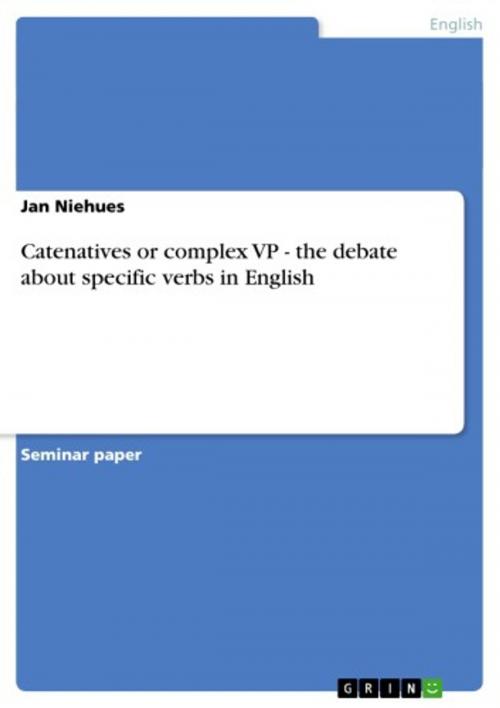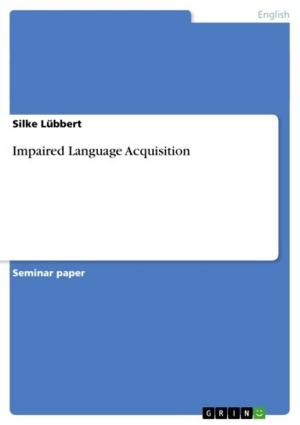Catenatives or complex VP - the debate about specific verbs in English
the debate about specific verbs in English
Nonfiction, Entertainment, Drama, Anthologies| Author: | Jan Niehues | ISBN: | 9783638480499 |
| Publisher: | GRIN Publishing | Publication: | March 17, 2006 |
| Imprint: | GRIN Publishing | Language: | English |
| Author: | Jan Niehues |
| ISBN: | 9783638480499 |
| Publisher: | GRIN Publishing |
| Publication: | March 17, 2006 |
| Imprint: | GRIN Publishing |
| Language: | English |
Seminar paper from the year 2005 in the subject English Language and Literature Studies - Linguistics, grade: 1, University of Marburg, course: Problems of English Grammar, 14 entries in the bibliography, language: English, abstract: Most linguists agree that there is a particular feature of certain verbs like e.g. want, begin, try or seem that sets them apart from other verbs: their ability to be combined into chains of verbs, to 'catenate' (Lat. catena: chain). (1) I don't want to have to be forced to begin to try to make more money. (Palmer 1987: 172) The term usually used for these verbs is 'catenative verbs'. There remains some form of disagreement about almost every aspect of these verbs, however, ranging from the question which verbs actually are catenative, to the problem of how to analyse or categorise them. Some linguists even question the need to define a class of catenative verbs in the first place. Huddleston concedes that: 'This is one of the most difficult areas of English grammar and despite a great deal of intensive study over the last twenty years there remains much disagreement over the most basic aspects of the analysis.'(Huddleston 1997: 209) The treatment of the grammatical phenomena is further complicated by the fact that linguists tend to introduce their own categories or descriptions for existing categories. This is particularly evident in the argument of modals vs. auxiliaries vs. operators. An approach differing from that traditionally taken by grammarians is that presented by Dieter Mindt who bases his observations on the analysis of a corpus of actual language. This paper gives an overview of the theories concerning catenative verbs, their relation to the auxiliaries and their features of clause complementation. Due to the scope of work that has been published, only the main approaches will be considered. The field of semantics in particular would merit a much closer look on the effects of sentence taxis.
Seminar paper from the year 2005 in the subject English Language and Literature Studies - Linguistics, grade: 1, University of Marburg, course: Problems of English Grammar, 14 entries in the bibliography, language: English, abstract: Most linguists agree that there is a particular feature of certain verbs like e.g. want, begin, try or seem that sets them apart from other verbs: their ability to be combined into chains of verbs, to 'catenate' (Lat. catena: chain). (1) I don't want to have to be forced to begin to try to make more money. (Palmer 1987: 172) The term usually used for these verbs is 'catenative verbs'. There remains some form of disagreement about almost every aspect of these verbs, however, ranging from the question which verbs actually are catenative, to the problem of how to analyse or categorise them. Some linguists even question the need to define a class of catenative verbs in the first place. Huddleston concedes that: 'This is one of the most difficult areas of English grammar and despite a great deal of intensive study over the last twenty years there remains much disagreement over the most basic aspects of the analysis.'(Huddleston 1997: 209) The treatment of the grammatical phenomena is further complicated by the fact that linguists tend to introduce their own categories or descriptions for existing categories. This is particularly evident in the argument of modals vs. auxiliaries vs. operators. An approach differing from that traditionally taken by grammarians is that presented by Dieter Mindt who bases his observations on the analysis of a corpus of actual language. This paper gives an overview of the theories concerning catenative verbs, their relation to the auxiliaries and their features of clause complementation. Due to the scope of work that has been published, only the main approaches will be considered. The field of semantics in particular would merit a much closer look on the effects of sentence taxis.















